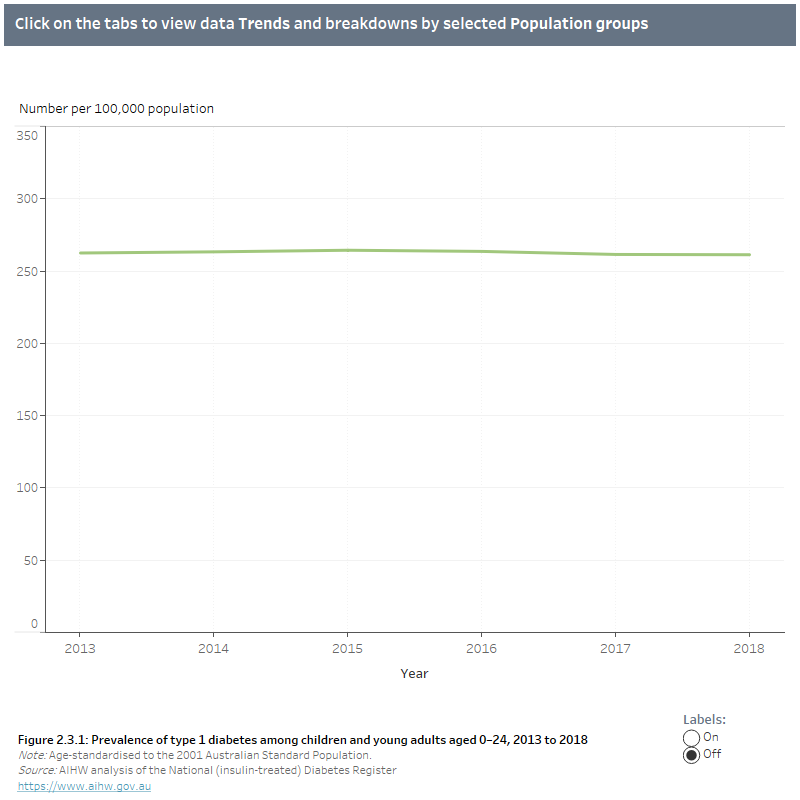Indicator 2.3 Prevalence of type 1 diabetes
Considerations
- There are currently no national data on the prevalence of type 1 diabetes at all ages, but there are estimates for children and young adults.
- The relatively low prevalence of type 1 diabetes, in addition to issues regarding accuracy of reporting relating to diabetes type (i.e. type 1 vs type 2), means producing reliable estimates further disaggregated by age group, sex and population characteristics is currently challenging.
Overview
As at 31 December 2018, 20,700 children and young adults aged 0–24 had type 1 diabetes in Australia, equating to a prevalence rate of 261 per 100,000 population.
Trends
The age-standardised prevalence of type 1 diabetes among children and young adults aged 0–24 remained relatively stable during 2013–2018, between 261 and 264 per 100,000 population (Figure 2.3.1).
Age and sex
In 2018, age-standardised rates were slightly higher among males aged 0–24 than females aged 0–24 (266 and 256 per 100,000 population, respectively) while overall, more than two-thirds (67%) were aged 15–24.
Population groups
In 2018, the age-standardised prevalence of type 1 diabetes among children and young adults aged 0–24 was higher in Inner regional and Outer regional areas (169 and 149 per 100,000 population, respectively), compared with 134 per 100,000 population living in Major cities (Figure 2.3.2). Rates were slightly higher among the lowest socioeconomic areas compared with the highest socioeconomic areas (263 and 235 per 100,000, respectively) (Figure 2.3.2).
State and territory
In 2018, the age-standardised prevalence of type 1 diabetes among children and young adults aged 0–24 was highest in Tasmania, with 320 per 100,000 population. The age-standardised prevalence of type 1 diabetes among children and young adults aged 0–24 was lowest in the Australian Capital Territory, with 195 per 100,000 population. Other states had prevalence rates ranging from 249 to 290 per 100,000 population (Figure 2.3.2).
Aboriginal and Torres Strait Islander people
Among Aboriginal and Torres Strait Islander children and young adults aged 0–24, there were 208 cases of type 1 diabetes per 100,000 population in 2018. After adjusting for age, Indigenous children and young adults were less likely to have type 1 diabetes than their non-Indigenous counterparts (197 and 232 per 100,000, respectively) (Figure 2.3.2).
Explore the data
2.3 Prevalence of type 1 diabetes among children and young adults aged 0–24, 2013 to 2018 and by selected population group, 2018
Trends figure 2.3.1 shows the prevalence of type 1 diabetes among children and young adults aged 0–24 was stable between 2013 and 2018 with rates ranging from 261 to 264 per 100,000 population.
Population group figure 2.3.2 shows the prevalence of type 1 diabetes among children and young adults aged 0–24 varied by selected population group in 2018. Prevalence rates were slightly higher among males overall compared with females (266 and 256 per 100,000, respectively). Rates peaked in the 20–24 age group both for males and females with 461 and 421 per 100,000 population, respectively. Indigenous males were less likely to have type 1 diabetes than non-Indigenous males (177 compared with 237 per 100,000) whereas rates among Indigenous females were similar to that of non-Indigenous females (219 and 226 per 100,000). The prevalence of type 1 diabetes among children and young adults was similar by socioeconomic area though varied by remoteness level from 86 per 100,000 in Remote and very remote areas to 169 per 100,000 in Inner regional areas. Rates varied by state and territory from 195 per 100,000 in the Northern Territory to 320 per 100,000 in Tasmania.

| Definition | Data source | |
|---|---|---|
|
Numerator |
Number of cases of type 1 diabetes (0–24 years). |
AIHW NDR 2018 |
|
Denominator |
Estimated Australian resident population (0–24 years). |
AIHW Population Database (sourced from ABS Australian Demographic Statistics and Estimates and Projections, Aboriginal and Torres Strait Islander Australians) |


